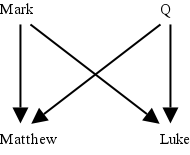Two-source hypothesis
|
|
The Two-Source Hypothesis is the most commonly accepted solution to the synoptic problem among biblical scholars, which posits that there are two sources to Gospel of Matthew and Gospel of Luke: the Gospel of Mark and a lost, hypothetical sayings collection called Q.
The Two-Source Hypothesis was first articulated in 1838 by Christian Hermann Weisse, but it did not gain wide acceptance among German critics until Heinrich Julius Holtzmann endorsed it in 1863. Prior to Holtzmann, most Catholic scholars held to the Augustinian hypothesis (Matthew → Mark → Luke) and Protestant biblical critics favored the Griesbach hypothesis (Matthew → Luke → Mark).
The Two-Source Hypothesis crossed the channel into England in the 1880s primarily due to the efforts of William Sanday, but it was Burnett Hillman Streeter who definitively expressed the case in 1924. Streeter further argued that a third source, referred to as M and also hypothetical, lies behind the material in Matthew that has no parallel in Mark or Luke (and L for Luke). Through the remainder of the 20th century there were various challenges and refinements of Streeter's hypothesis, such as Parker (1953) who posited an early version of Matthew (proto-Matthew) as the primary source of both Matthew and Mark, and Q source used by Matthew. It is now generally accepted that the Gospel of Matthew was not written by Matthew.
The Griesbach hypothesis of Johann Jakob Griesbach continues to be the main challenger to the Two-Source Hypothesis in America, primarily due to the efforts of William R. Farmer (1965), but in England its most influential opponents favor the Farrer hypothesis (Mark → Matthew → Luke).

